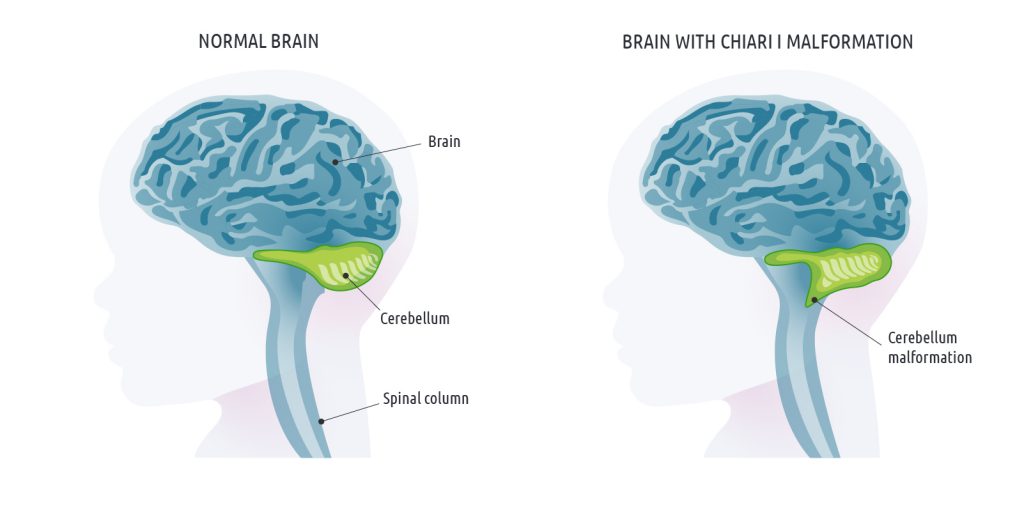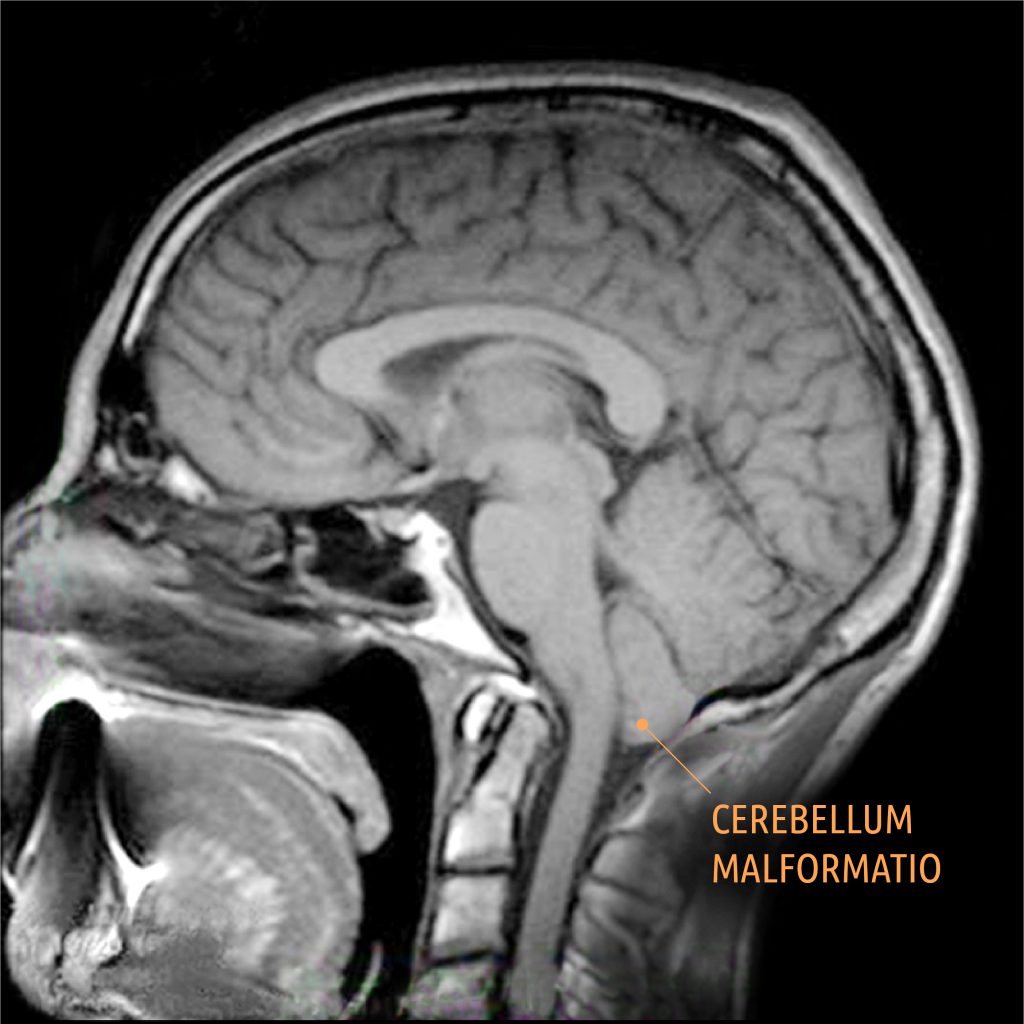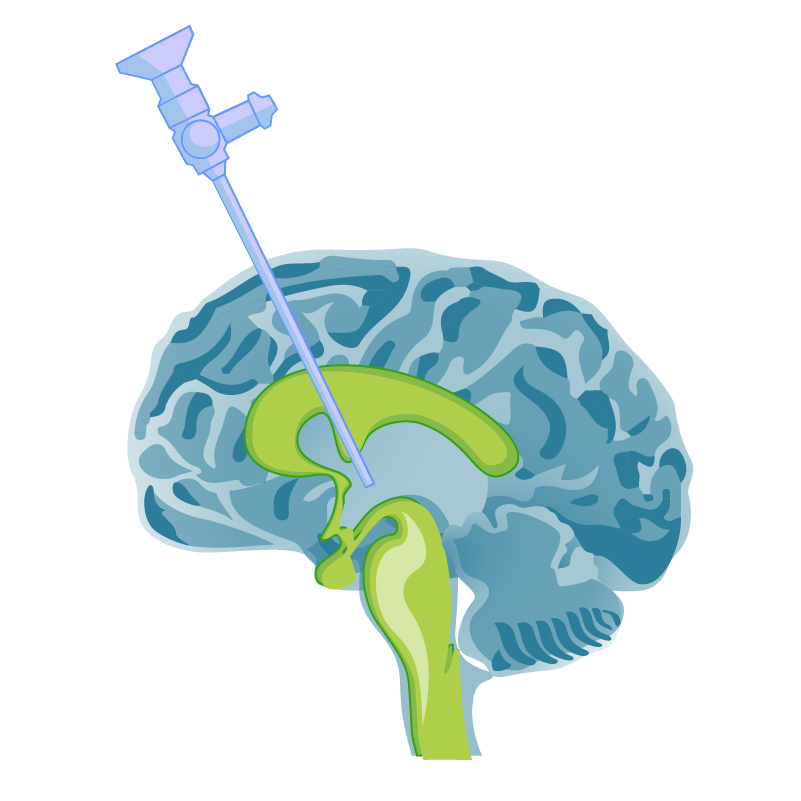Chiari Malformation
Chiari Malformation
Chiari Malformation is a condition in which brain tissue may protrude through an opening in the base of the skull and into the spinal cord. This condition may happen when part of the skull is too small or has an unusual shape, pressing on the brain tissue and forcing it downward.
Classification
Type I Chiari Malformation occurs when the brain and skull are at their growing stage. Thus, the symptoms and signs do not happen until the latter part of childhood or adulthood.
Type II Chiari Malformation, which is the most common form, happens at birth and is described consequently as being congenital. Treatment depends on the seriousness of the condition, its form, and the symptoms related to it. Some of the possible options for treatment are medications and in some cases surgery.

Type III Chiari Malformation is one of the rarest and most serious types of this disorder. It happens when a portion of the brain’s stem protrudes into the spinal cord. This type of Chiari Malformation is usually discovered at birth or during an ultrasound while the mother is pregnant. This condition usually causes complex neurological defects.
Type IV Chiari Malformation is also known as Cerebellar Hypoplasia. This rare type of Chiari Malformation is characterized by a lack of cerebellar development in which the cerebellum and brain stem lie in a normal position, but portions of the cerebellum are possibly missing or underdeveloped. This condition is not compatible with life.
Doctors have identified and classified Chiari Malformation symptoms based on the anatomical make-up of the displaced tissue in the spine’s canal and whether there are abnormalities that developed in the spine or in the brain. Many individuals with Chiari Malformation do not develop symptoms and usually do not require any treatment. Their disorder is revealed only when tests are done for unrelated conditions. Depending on its type and severity, Chiari Malformation may cause numerous complications.
Reasons
Type I Chiari Malformation occurs when the segment of your skull containing a piece of your cerebrum (cerebellum) is not fully developed or is twisted. The lower part, or tonsils, of the cerebellum, are dislodged into the upper spinal trench.
Type II Chiari Malformation symptoms are usually associated with a type of Spina Bifida called Myelomeningocele.
At the point when the cerebellum is pushed into the upper spinal waterway, it can disrupt the normal stream of cerebrospinal liquid that flows to the cerebrum and spinal cord.
This disruptive flow of cerebrospinal liquid can prompt the blockage of brain signals transmitted to the body, or to a development of spinal liquid in the cerebrum or spinal cord.
Additionally, the weight of the cerebellum upon the spinal cord or lower brainstem can cause neurological signs or manifestations.
Chiari Malformation symptoms may include:
-
- Some structural defects in the brain and spinal cord that develop during fetal development (may be connected to genetic mutations or severe deficiency in mother's diet) that leads to Chiari Malformation symptoms.
- Herniated cerebellum tissue may disturb the spinal fluid flow and cause additional neurological signs or symptoms.
Prevalence
The prevalence of Type I Chiari Malformation symptoms is approximately 1:1000 births. Females are three times more likely to be affected than men. Type II Chiari Malformation symptoms may be more prevalent in some ethnic groups.
Risk factors
There is no clear evidence of any risk factors connected to Chiari Malformation symptoms. However, some scientists suggest that Chiari Malformation is hereditary and may be observed in some predisposed families more often.
Complications
In certain individuals, Chiari Malformation may develop into a more dynamic issue and prompt genuine concerns. In others, there may be no related side effects, thus no medication is needed. The intricacies related to this condition include:
-
- Hydrocephalus: A condition in which there is an abundance of fluid in the brain (hydrocephalus). This condition may require the arrangement of an adaptable tube (shunt) to redirect or deplete the excess cerebrospinal fluid.
-
- Spina Bifida: Spina Bifida is a type of birth defect and occurs when the bones of the spine do not form properly around the spinal cord, thus leaving some portion of the spinal cord uncovered. Individuals with Type II Chiari Malformation often have a type of Spina Bifida called Myelomeningocele.
-
- Syringomyelia: Certain individuals with Chiari Distortion additionally build up a condition called Syringomyelia which is a cyst (syrinx) that forms inside the spinal cord.
- Tethered Cord Syndrome: A functional disorder where the spinal cord connects to the spine thus limiting its ability to stretch impairing movement.
You may also find interesting in:
Chiari Malformation Symptoms List
Individuals may have Type I Chiari Malformation for a considerable length of time without showing any symptoms. Chiari Malformation symptoms may not develop until childhood or early adulthood. Often the malformation is not recognized until a patient has an MRI exam for another reason, however, it's all the more commonly discovered after manifestations begin to show up.
Type I Chiari Malformation symptoms include but are not limited to the following:
- - Severe headache due to abrupt coughing or sneezing
- - Neck pain
- - Inability to properly balance
- - Numbness and tingling sensation in hands & legs
- - Dizziness
- - Disruption of basic motor skills
- - Problems with speech (voice getting hoarse)
- - Difficulty swallowing
- - Blurred vision
- - Ears ringing
- - Weakness
- - Slowed heart rate
- - Abnormal breathing
- - Scoliosis
Type II Chiari Malformation symptoms include but are not limited to the following:
- - Changes in the pattern of breath
- - Difficulty swallowing
- - Weakness in the arms
- - Rapid downward eye movements
Individuals that develop Syringomyelia additionally may experience difficulty performing normal hand motor skills, trouble walking, and incontinence.
Individuals showing Chiari Malformation symptoms should contact their physician or specialist for counsel.
Diagnostic procedures
The list of Chiari Malformation symptoms can be hard to analyze since the side effects can be ambiguous, or non-existent. An authoritative determination is by and large made after an MRI test, where the bulge of the cerebellum toward the spinal cord can be seen. Sometimes, the conclusion might be accidental, implying that an individual who experiences an MRI check for another reason might be determined to have Chiari when the sweep uncovers the variation from the norm.
Any individual who gets a speculative determination of Chiari should be directed to a neurosurgeon, who will conduct a full assessment and determine a course of treatment.
Additionally, an MRI output of the cerebrum and MRI of the entire spine is valuable in determining the necessary procedures for treatment. In a few individuals with Chiari, a growth (known as a syrinx or syringomyelia), forms inside the spinal cord. Side effects of leg numbness or scoliosis are more probable when a syrinx exists.
Chiari Malformation is regularly discovered during pregnancy amid ultrasound test, or during childbirth. In the event that there are no indications, a physician may discover it unintentionally when the individual is being examined for an alternate condition. The type of Chiari Malformation exhibited relies upon:
- - Medical history
- - Manifestations
- - Clinical assessment
- - Imaging test
- - Physical exam
Amid a physical exam, the physician will evaluate capacities that might be influenced by Chiari Malformation, including:
- - Balance
- - Perception
- - Memory
- - Motor skills
- - Reflexes
- - Sensation
In addition to a physical examination, the physician may recommend conducting imaging tests to identify the root cause of the disorder. This may include any of the following:
1) Magnetic Resonance Imaging (MRI) – This is a testing method that will show detailed images of any non-normal brain structures that may be prompting the Chiari Malformation symptoms. It will also show if the cerebellum has extended to the spine’s canal. This imaging test can repeat periodically to monitor the progression of Chiari Malformation.

2) Computerized Tomography (CT) scan– This form of testing uses x-rays to view body images taken from various angles. It can aid in revealing if there are any tumors in the brain, damage or bone abnormalities as well as any blood vessel distortions and other conditions such as Chiari Malformation.
Chiari Malformation Treatment and Care
Depending on the severity of the Chiari Malformation and its symptoms, the Chiari Malformation treatment may vary. If there are no symptoms, chances are, the physician will recommend no Chiari Malformation treatment, other than periodic MRI’s or physical examinations.
Headaches and other pains caused by Chiari Malformation may be required for medicinal treatment.
Surgery is the typical Chiari Malformation treatment to relieve the pressure and pain, especially when the symptoms of Chiari Malformation are chronic. The intent of the surgery is to stop the changing medical developments happening to the brain and spine while neutralizing the symptoms. Optimally this procedure will relieve the pressure on the brain and spinal cord caused by Chiari Malformation and allow the spinal fluid to begin flowing normally again.
Chiari Malformation treatment is dependent upon whether the individual currently has any side effects and their severity.
Prescribed pain medicine can help mitigate any migraines and neck pain.
Surgery may be advised for severe migraines or excessive pressure that is being applied to the spinal cord.
Surgery
Decompression surgery is the primary operation for Chiari Malformation.
Under general anesthesia, an incision is made on the back, lower part of the head where a small portion of bone is extracted from the base of the skull or highest point of the spine, thus relieving the pressure on the cerebrum and allow the fluids in and around the brain and spinal cord to flow as normal.
Alternative surgical proceeders may include or not limited to the following:
- Endoscopic Third Ventriculostomy (ETV) – a small opening is created in the floor of the third ventricle thus allowing fluid to flow directly to the basal cisterns, bypassing the obstruction. See treating hydrocephalus for more data.

-
- Ventriculoperitoneal Shunting – a small opening is bored into the skull where a catheter is passed into the area to deplete the excess fluid and release pressure. See treating hydrocephalus for more data.
-
- Untethering – Untethering is a procedure that detaches the spinal cord from the spinal column allowing for greater mobility and movement.
- Spinal Fixation – Certain individuals with Type I Chiari Malformations also have a hypermobility disorder, for example, Ehlers-Danlos disorder, which may require surgery as the primary Chiari Malformation treatment in order to balance out the spine.
The intent of surgery is to correct the medical disorder thus preventing the side effects from deteriorating. Additionally, certain individuals may experience a change in their manifestations, especially migraines.
In isolated cases, surgery brings about no corrections or changes in the manifestations deteriorating. Additionally, there is a risk of paralysis or stroke.
Medical Therapy
Individuals with Type I Chiari Malformations who have negligible or dubious side effects without syringomyelia can be dealt with conservatively. Neck pain and migraines can be treated with analgesics, muscle relaxants or other medicines.
A medical study of symptomatic patients who did not experience surgery found that cerebral pain queasiness still frequently enhanced, yet ataxia and tactile unsettling influence did not indicate an unconstrained change. Approximately 93% of asymptomatic patients with Type I Chiari Malformation stayed asymptomatic, regardless of the possibility that syringomyelia was available.
Pathological changes
Most individuals who have developed Chiari Malformation, no symptoms are observed and no Chiari malformation treatment is required. In others, it can become a disorder that keeps progressing and can lead to more serious complications such as the following:
a) Excess fluid in the brain (Hydrocephalus) may prompt a physician to surgically redirect the fluid towards another area of the body via placement of a shunt for Chiari Malformation treatment.
b) The emergence of Spina Bifida may bring on paralysis as a result of Chiari Malformation.
c) The emergence of Roped Cord Syndrome. This is a condition where the spinal cord adheres to the spinal column, resulting in the spinal cord being unduly stretched. This causes severe damage to the nerves and muscles of the lower body as a complication of Chiari Malformation.






